Transportation is a human right
Faculty, students and alumni make the case for transportation justice
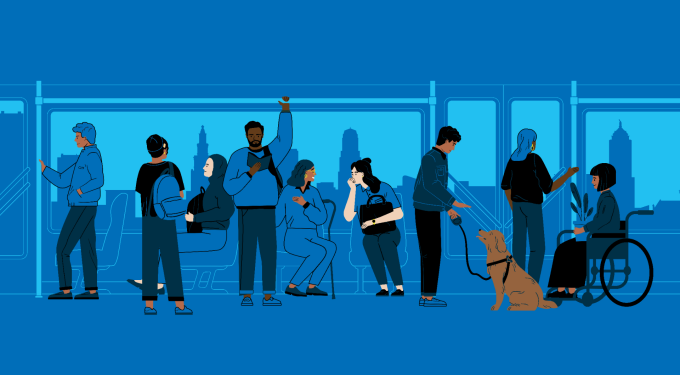
By Matthew Biddle
MSW student Tory Medley knows what it’s like to rely on public transportation in a city like Buffalo.
As a teenager, she received a free metro card to get to school but recalls times when she felt unsafe or would wind up late because a bus was full.
“It could be a sketchy walk just to get from the train station to school,” she remembers. “You're walking down these back streets where most of the homes are abandoned. You have people selling drugs on the corners, and there were times people were robbed.”
Later, as a young adult, she faced a common challenge: She needed a steady income to pay for her bus pass but needed public transit to get to work in the first place.
“There were plenty of times when I could not afford a bus ticket, so I would walk an hour to get to work in rain, sun, snow — you name it,” she says. “It was very hard.”
Though Medley now has a car and can move around with relative ease, she’s still passionate about advocating for transportation as a human right. This winter, she spoke out during a local press conference on Transit Equity Day, a national day of action.
“I know kids who were let down by systems like this. If you’re late to the bus stop or are a few minutes after your card expires, you’re stranded. That’s a terrifying experience for a child,” she says. “We need to have these conversations so we can do better in the future.”
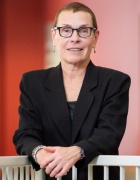
Diane Elze
Transportation affects nearly every aspect of our lives. We need a way to get to work or school, buy food and necessities, access medical care, connect with loved ones — the list goes on. Access to safe transportation is recognized as a social determinant of health by the U.S. Department of Health and Human Services, and research shows that unreliable or inadequate transportation creates barriers to accessing employment, housing, fresh food and more.
Simply put, the Universal Declaration of Human Rights declares, “Everyone has the right to freedom of movement and residence within the borders of each state.”
“Without affordable public transportation, our society is more unequal,” says Diane Elze, associate professor emeritus. “Lack of access to transportation exacerbates racial and economic disparities in our country. When we look at the building of highway systems in this country, and how it destroyed Black neighborhoods, we can see that the lack of public transportation is grounded in white supremacy.
“Even more than a social determinant of health, transportation is a human right.”
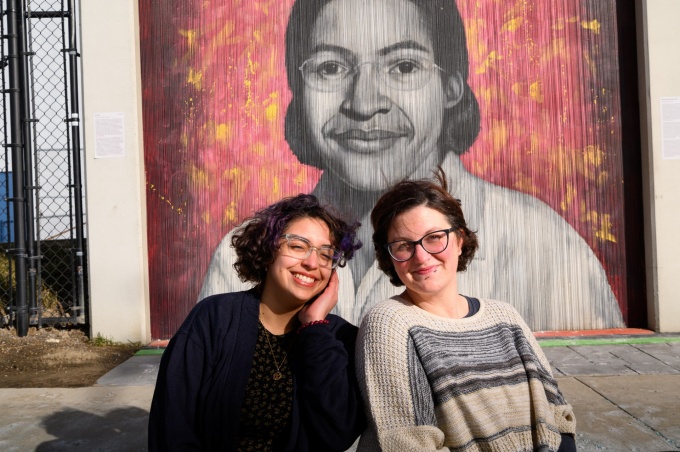
Transit Equity Day coincides each year with Rosa Parks’ birthday. Here, Tory Medley and Iris Marrano visit her portrait, painted by Julia Bottoms-Douglas, on the Freedom Wall in Buffalo. Photo: Olivia Marone
Barriers and disparities
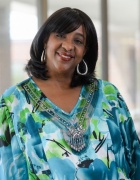
Kelly Patterson
Buffalo is one of the most segregated cities in America, a fact that came into stark focus in the wake of the racially fueled massacre at Tops in 2022.
A recent study by Partnership for the Public Good (PPG), for example, showed that Erie County residents of color are disproportionately concentrated in high-poverty, urban neighborhoods that suffer from disinvestments in basic infrastructure. More than 56,000 Buffalo households don’t own a vehicle — but 58% of local jobs are beyond the reach of transit networks, according to PPG.
In her research, Associate Professor Kelly Patterson looks at how affordable housing policies affect residents’ access to “valued resources,” including employment and health care, particularly in shrinking cities like Buffalo.
“Many jobs have left urban areas and went out to the periphery or the suburbs, where people cannot easily access them,” she says. This shift creates longer commutes for workers who live in cities, challenges for people who rely on public transit and an increased dependency on cars — all of which puts pressure on transportation systems and affects the environment.
Low-income populations also experience health disparities when they are limited by inadequate transportation and crumbling infrastructure in their own neighborhood.
“Because of poorly maintained roads, uneven sidewalks and broken streetlights, people in poor neighborhoods don’t get the physical activity that many people in suburbs get for free because they can go for a walk or jog at all times of the day,” Patterson says.
— Kelly Patterson, PhD, associate professor, UB School of Social Work
A recent Robert Wood Johnson Foundation study found that one in five Americans without transportation access — including a disproportionate percentage of Black adults — forgo medical care each year. According to the U.S. Department of Agriculture, about 23.5 million Americans live in a food desert, or a low-income area with limited mobility and grocery options. Patterson cites an example of an acquaintance who must take four buses to get to a store where they feel safe after the Tops attack.
As one policy solution, Patterson recommends building affordable housing near transit options and anchor institutions, like universities or hospitals, to encourage further development, like retail and cultural amenities.
She emphasizes, though: “Without affordable housing, people can be priced out of these growing neighborhoods. That’s why a transit-oriented development strategy where affordable housing is built near anchor institutions and transit hubs is better for low-income areas — creating more rail lines, bus stops and walkable neighborhoods.”
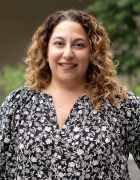
Amanda Aykanian
Assistant Professor Amanda Aykanian studies how a lack of mobility can hold people back as they try to exit homelessness. For one paper, she interviewed workers at homeless service agencies in 21 New York State counties, documenting hurdles in the housing process, which often necessitates moving to rural and other communities without public transit.
“Because the housing market in cities is usually expensive, you may need to look 30 to 45 minutes outside the city to house people in an affordable place,” she says. “But if you are putting them in a place that makes it even harder for them to stay connected to services, then you risk the fact that housing can be actually detrimental if it means having less access to their mental and physical health care providers, sources of food, even friends and family.”
Though Medicaid can provide transportation for medical appointments, few providers offer solutions for other services or needs.
“Think about what your daily life looks like,” she says. “Whether it’s work, visiting friends, grocery shopping — most people cannot access those things in an easy walking distance, assuming you have the ability to walk a couple miles at all.”
Aykanian points to telehealth and co-locating services at community centers, like public libraries, as useful solutions. She also wishes more municipalities would provide free subway tokens to agencies for clients.
“It’s such an unnecessary barrier with an easy solution in a lot of ways. Providing more access is not a high-cost endeavor — it just requires political will,” she says. “The nice thing about transportation from a political perspective is that it’s a local issue, so you can contact your elected officials and elevate your concerns.”
— Holly Nowak, MSW ’17, executive director, Coalition for Economic Justice
Pushing for solutions
Holly Nowak, MSW ’17, has been on the front lines of this issue since she interned at the Coalition for Economic Justice (CEJ) in 2016 — the same year CEJ launched its Buffalo Transit Riders United (BTRU) campaign.
“Transportation is the difference between surviving and thriving,” Nowak says. “Transportation justice intersects with just about any other kind of justice you can think of. It’s a class issue, it’s a race issue, it’s access to health care, child care and education.”
She’s now CEJ’s executive director, and BTRU has scored several major wins. Activists successfully pushed to change routes in Lackawanna to increase access, lobbied for a state law that requires every transit authority to grant voting rights to someone who relies on public transit, and secured a daily and monthly cap on fares from the Niagara Frontier Transportation Authority (NFTA), which operates Buffalo’s metro buses and rail.
Of course, there’s plenty more to do. BTRU continues to fight for greater transparency, accountability and service at the NFTA, as well as solutions to address the shortage of drivers.
As a field intern at CEJ this year, MSW student Iris Marrano has supported BTRU’s advocacy efforts by assisting with grant writing, promoting events, drafting letters to policymakers and more. She’s also seen the impact of this issue firsthand as a mobile counselor at BestSelf Behavioral Health.
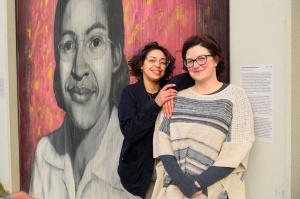
Medley and Marrano at the Freedom Wall. Photo: Olivia Marone
“I go to people’s homes who don’t have a lot of access or ability to get out. But when they do need to go places, it’s challenging because they can’t always rely on buses to show up, and the conditions getting to a bus stop may not be accessible or safe for people who are differently abled,” she says. “Clients may go without physical health appointments for a long time because of stress related to accessing transportation.”
As part of her field placement, Marrano helped to organize the Transit Equity Day celebration, which Tory Medley spoke at, to push for more equitable, accessible and functional transit options for all. She also attended the World Bank’s Transforming Transportation conference in Washington, D.C., which centered on climate action in the transit space.
The entire experience has fueled Marrano’s passion for working with vulnerable communities — and advocating for positive change at a macro level.
“In an ideal world, transit would be fair-free, which some places are doing, and the designers would work directly with people using the transportation before implementing changes,” she says. “We’re also a very racially segregated city, and we need to realize transportation is a racial issue and treat it as such to make some progress.”